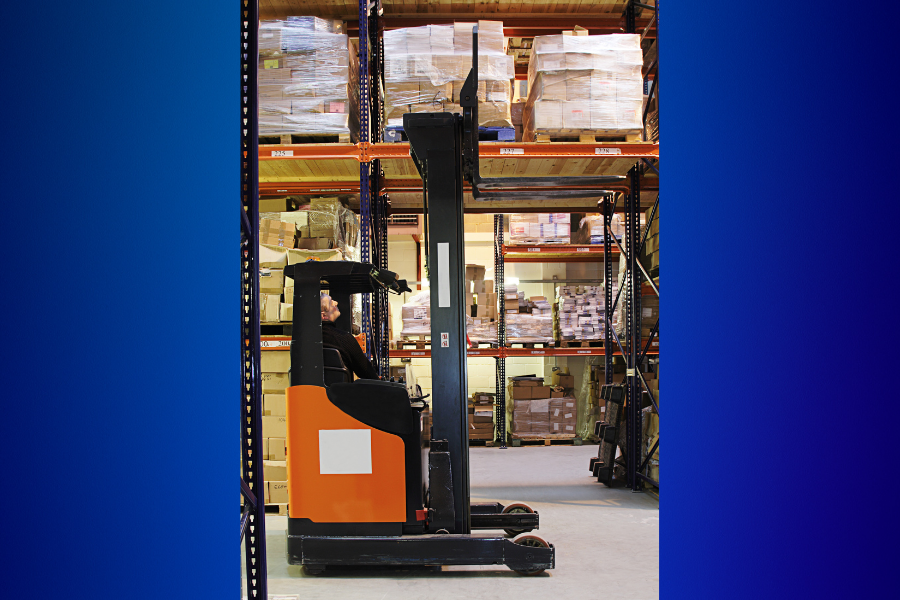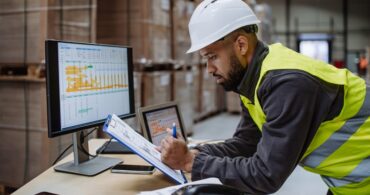Warehouse space becomes more valuable every year. One way to get the most from an existing space is to add more shelving and narrow the aisles. However, many forklifts cannot navigate these new, smaller passages. That’s where a reach truck swoops in to save the day.
However, size is not the only significant difference between reach trucks and forklifts. It’s the vehicle’s namesake. A reach forklift can literally “reach” into the shelves to place and retrieve pallets.
Is a reach truck considered to be a forklift?
Yes; however, officially, a forklift isn’t a forklift. It’s a powered industrial truck. At least, that’s how they are classified by the Occupational Safety and Health Administration (OSHA). OSHA has seven classifications of powered industrial trucks. What most people think of when they picture a forklift is a counterbalanced forklift, which falls under the first classification: electric motor rider trucks.
Reach trucks are found in the second classification: electric motor narrow aisle trucks. Class II trucks are designed to handle small spaces and narrow aisles with efficiency and speed. Many Class II vehicles are highly specialized or include attachments that adapt them for specific work. Other vehicles, in addition to the forklift reach truck, that are considered class II powered industrial trucks include order pickers (aka, cherry pickers) and side loaders.
How is a reach truck different than a counterbalanced forklift?
While there are obvious visual differences between a reach lift and a counterbalanced forklift, one of the most important distinctions is less apparent: how they remain balanced while lifting a load.
When a forklift is referred to as counterbalanced, it means that the heavy battery that powers the machine and other weights in the vehicle’s rear help the forklift remain level as it lifts a load and its center of gravity shifts. Counterbalanced forklifts have a three-point suspension system that helps distribute the vehicle’s weight. The area between those three points is known as the stability triangle. When not carrying a load, the forklift’s center of gravity is safely located in the middle of the stability triangle. However, once a forklift picks up a load, its center of gravity moves forward. The heavy weight in the vehicle’s rear helps counterbalance this shift, so the forklift remains steady.
Reach trucks are too small to utilize counterbalancing. They would be too heavy to efficiently move throughout a warehouse. Instead, a reach truck has two stabilizing legs (also known as outriggers or base legs) that extend parallel to the forks. The stabilizing legs create a secure base when lifting loads that prevent the machine from tipping forward. This design allows reach trucks to operate in narrow aisles and lift loads at high elevations without the need for a counterbalance weight.
A reach truck has forks attached to a mast at the front of the truck similar to a counterbalanced forklift, but reach trucks are much smaller. As a result, the reach truck operator either sits sideways or stands. In a stand up reach truck, the operator either faces forward or parallel to the direction of travel, depending on the design of the stand up reach forklift. Reach trucks commonly have two large rear wheels and two or four smaller front wheels nestled inside the base legs that extend from the front of the vehicle.
The average reach truck can raise a load approximately 40 feet. However, a specialized high reach forklift may be able to reach up to 60 feet.
What are the different types of reach trucks?
Single-reach trucks
Single-reach trucks are the most common type of reach truck. These machines can load a single pallet into racking, which means they are designed for lower to medium-height storage racks that are one pallet deep.
A single-reach truck has a compact and slender design, allowing it to navigate through aisles that are typically around eight to ten feet wide.
Double-reach trucks
A double-reach truck is similar to its single-reach brethren, except it can extend two pallets deep into storage racks. To accomplish this task, the forks are attached to a telescoping scissor mechanism.
The double-reach mechanism allows the reach truck to place and access pallets in very narrow aisles and reach greater depths in storage racks, making it suitable for high-density warehouse environments.
Moving mast reach trucks
A moving mast reach truck is pretty much what the name implies. Instead of using a scissor mechanism to reach into the racks, the entire mast on these trucks literally moves forward to place cargo. Because these trucks do not need to drive into the racks, they may have the same large wheels on the front as the back.
Multidirectional reach trucks
A multidirectional reach truck, also known as a side-loader, is a specialized type of forklift designed for handling long and bulky loads in narrow spaces. The distinguishing feature of a multidirectional reach truck is its wheels, which can rotate 90 degrees. This ability enables the reach truck to move in multiple directions, including forward, backward and sideways. This capability allows for increased maneuverability in tight aisles and facilitates the handling of long and awkward loads, like planks of wood or stacks of pipes.
Does a reach truck operator need training to drive a reach truck?
Yes. The operator of any forklift must complete training on their specific model of powered industrial truck before they operate it without supervision. An employer must ensure their employees are certified to operate the forklifts at their job site.
According to the Texas Department of Insurance. “It is the sole responsibility of the employer to certify that each operator has been trained and evaluated as required by the standard. Outside sources may be used to deliver training or even develop the PIT (powered industrial trucks) program, but only the employer is allowed to certify their PIT operators.”
Also, a reach truck operator does not need a valid class C driver’s license to operate a reach truck (for example, someone with a suspended driver’s license can still do their job as a forklift operator). However, companies can establish policies stating that forklift operators must have a state-issued driver’s license in addition to their forklift certification.
A final key component of the solution to “What is a reach truck?” is the battery used to power the vehicle. Are you certain that you have the best batters for your fleet? Texas Motive Solutions can help. We provide a complimentary forklift fleet performance analysis to guarantee you have the correct batteries for your needs. Plus, we have the forklift batteries and accessories you need to keep your fleet running. Give us a call at (888) 316-2459 or fill out this form to begin a service request and discover how we can keep your fleet running at peak efficiency.



